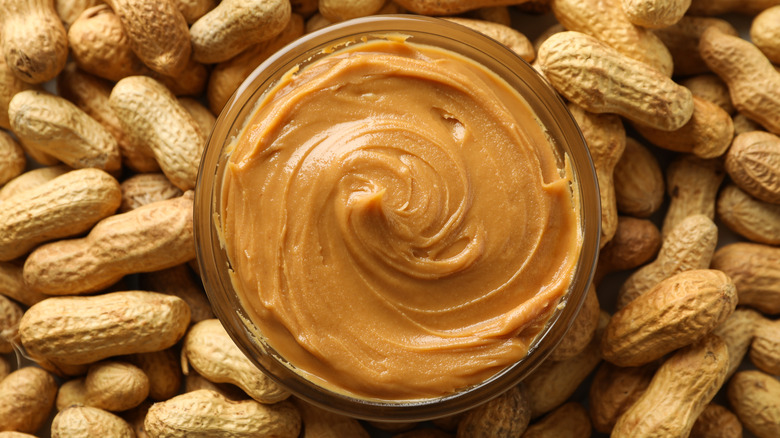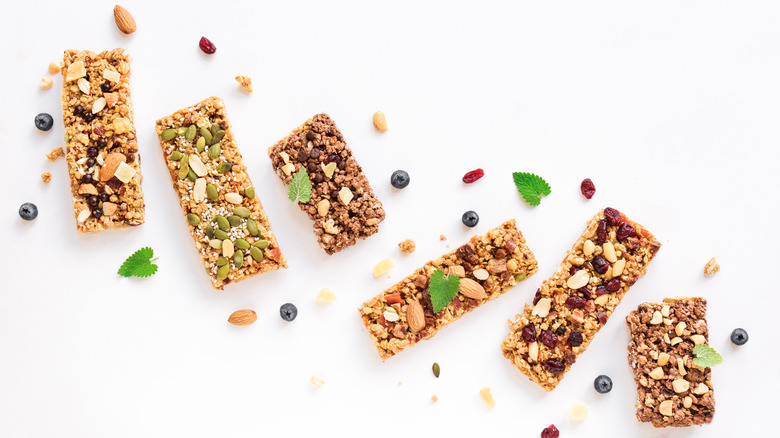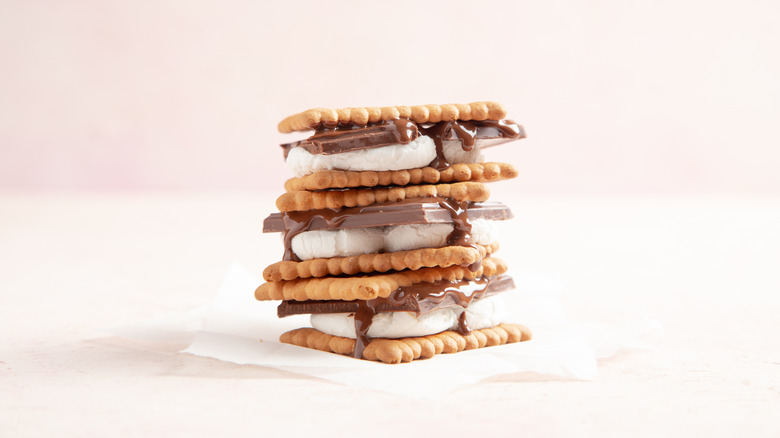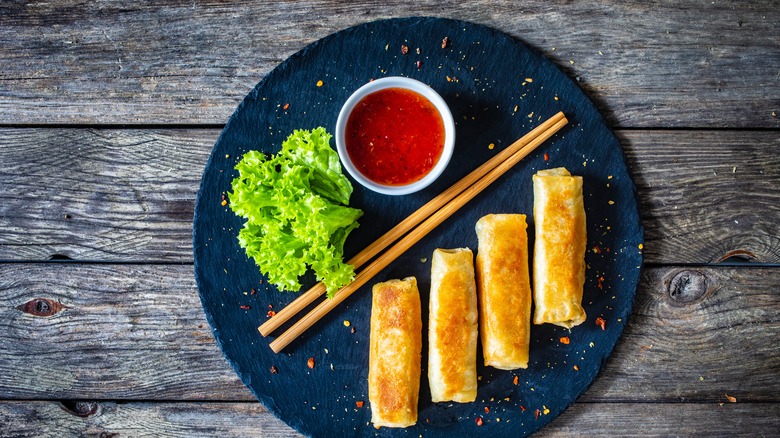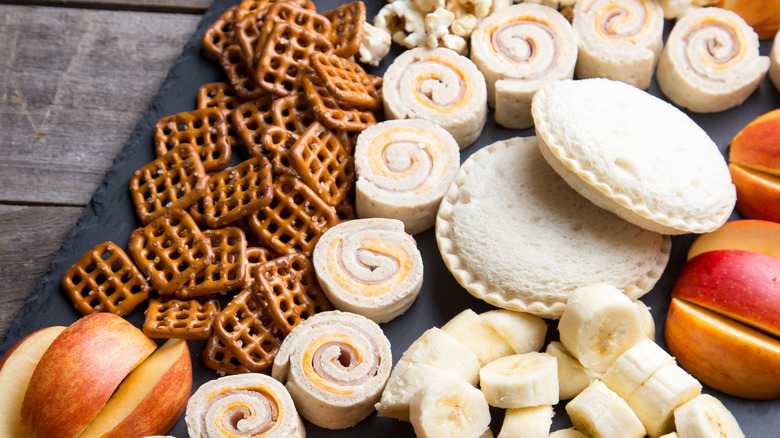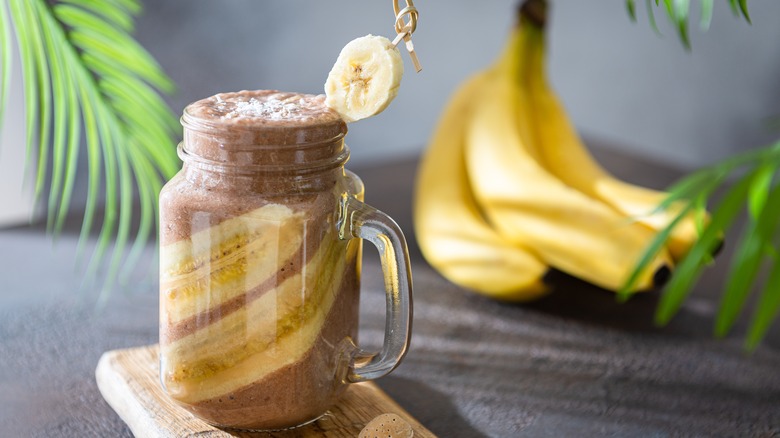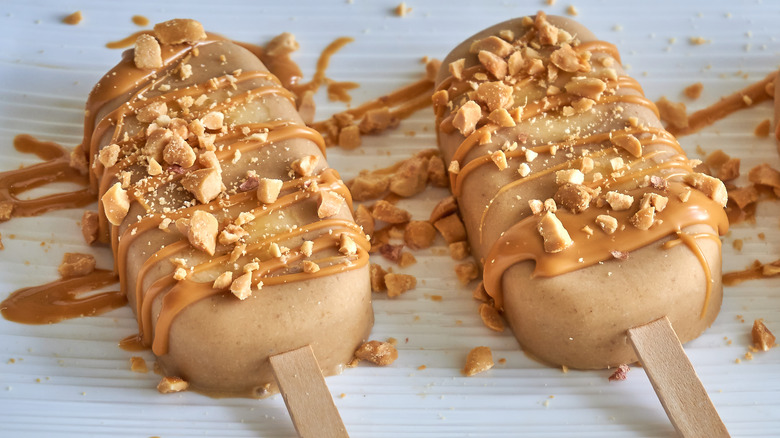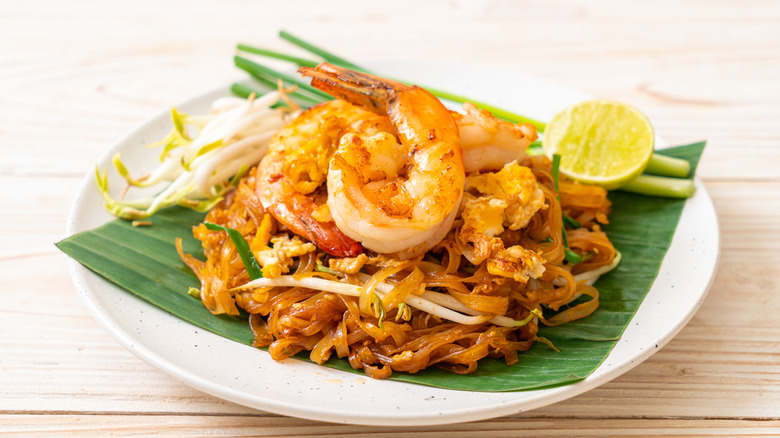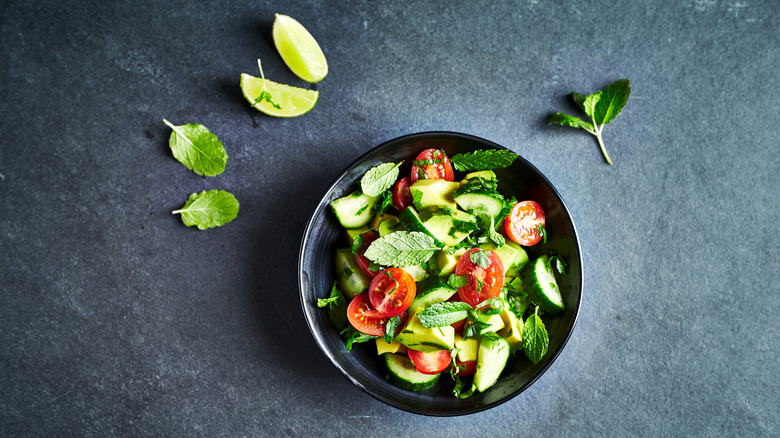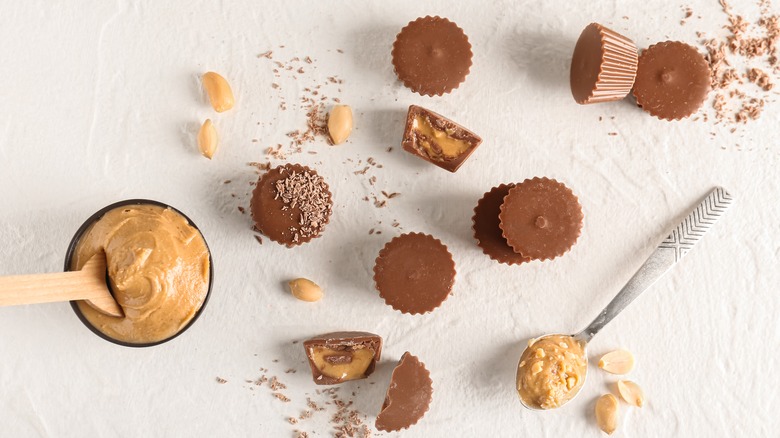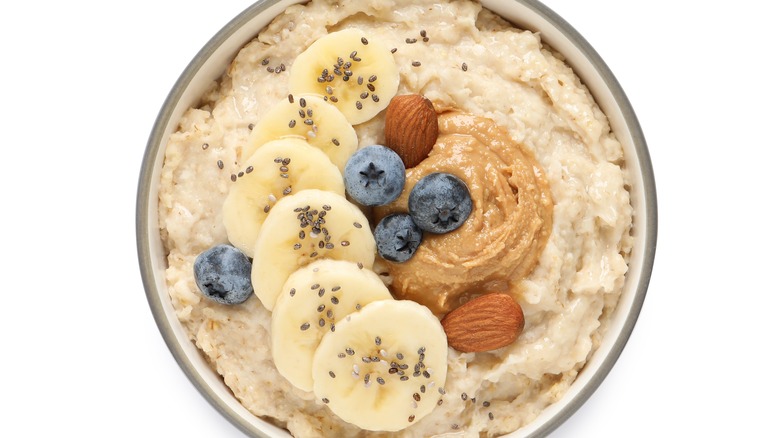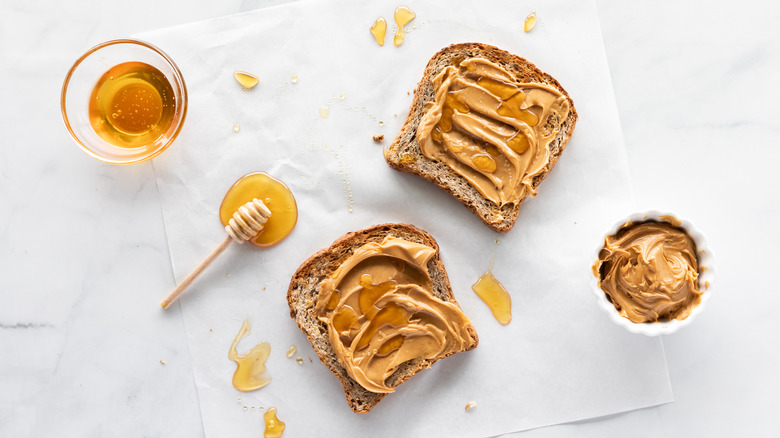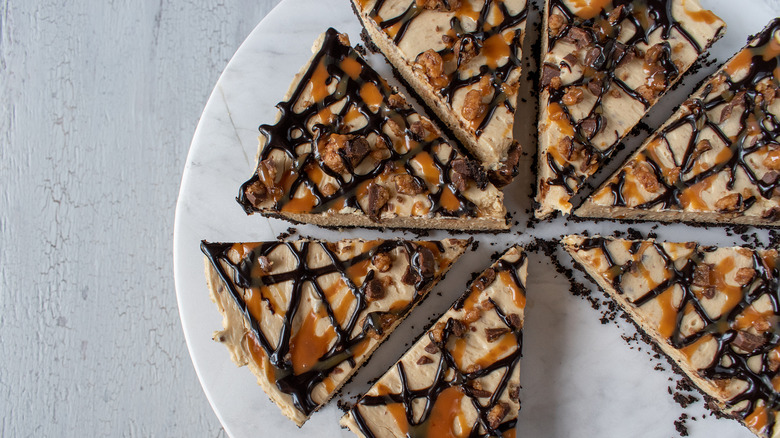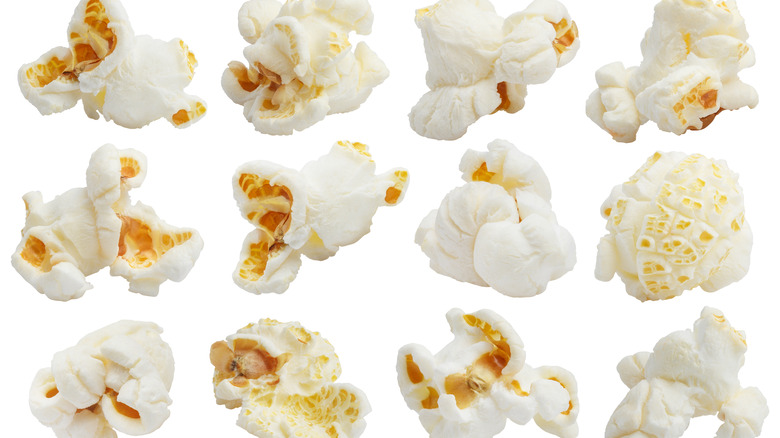13 Unconventional Ways To Use Peanut Butter
Peanuts are a legume high in macronutrients like protein and fat, as well as minerals like zinc, magnesium, and sodium. Although peanuts are mostly known for their role as a delicious spread known as peanut butter, peanuts are also used widely for confections, snack products, soups, and desserts, according to the National Library of Medicine. Peanut butter comes in several varieties including chunky, creamy, and natural (made without hydrogenated oil).
Peanut butter is a delicious source of protein (and joy) for many. Although lots of people recognize it for its pivotal role in the great American sandwich, the peanut butter and jelly, it is not often recognized for its versatility in both sweet and savory dishes. Realistically, peanuts can be used as a flavor cornerstone or a building block for other ingredients in a variety of recipes and cuisines. Here are some innovative ways to use peanut butter in your kitchen — that don't include putting it into a sandwich!
Make homemade granola bars
Granola bars can be easy to make at home with a variety of dried fruits, nuts, grains, and seeds. They can provide a powerful punch of protein, healthy fats, and carbohydrates that will keep you going all day long. Best of all, these granola bars can be customized to fit the flavors and textures you love.
Peanut butter is a sticky addition to homemade granola bars. Not only does the peanut butter provide a strong flavor to granola bars, but it can also help the oats, seeds, and nuts stick to one another. The Real Food Dietitians combine rolled oats, peanut butter, chocolate chips, maple syrup, and eggs together before baking in a 9x9 baking dish. These granola bars can be stored in the fridge for up to 10 days or in the freezer for a few months. For an egg-free recipe, try substituting flax eggs.
Spread it on a s'more
S'mores are a campfire classic made with a combination of crunchy graham crackers, melty chocolate, and puffy marshmallow. According to Camping for Foodies, there are many ways to jazz up the traditional s'mores to include some adult flavors — most of which include peanut butter. Consider swiping peanut butter on a graham cracker before adding chocolate and roasted marshmallow. Or, substitute a peanut butter cup for the square of Hershey's chocolate on the s'more. Although this might seem like the perfect ratio of peanut butter to chocolate, use a Reese's thin instead of a traditional peanut butter cup for maximum Reese's goodness.
To add even more peanut butter to the s'more, swap out the graham cracker for a peanut-y cookie or wafer. Nutter Butter wafer cookies combine a thin layer of peanut butter with an even thinner wafer cookie. For a more homemade feel, try a three-ingredient peanut butter cookie made with peanut butter, eggs, and sugar.
Make a dipping sauce for spring rolls
Spring rolls are a light, simple dish made with protein (typically chicken, shrimp, or tofu), fresh chopped veggies, and served with a complementary dipping sauce. The rolls can either be served fried or raw, making them a versatile addition to any dietary regiment.
To make a dipping sauce for spring rolls, Casa Lago Tasting Room recommends combining 1 cup of creamy peanut butter, lime juice, soy sauce, sriracha, and brown sugar in a serving dish. The sauce can be left in the fridge for several days making it a great match for lunchtime spring rolls during the week. Taste of Asian Food recommends adding spices like freshly grated ginger or garlic, which can add a spicy sensation to the spring roll (we're drooling already). Sesame oil can provide a new savory depth while maple syrup can provide a sweet undertone to the peanut sauce. Whatever variant you choose it's bound to be delicious.
Add it to a charcuterie board
Peanut butter is a great addition to a kid-friendly charcuterie board. The nut butter provides the essential fats and protein that growing kids need, but with a taste that folks of all ages love. Serve a scoop of your favorite crunchy or smooth peanut butter with pretzels, apple slices, banana slices, or celery. Kids love roll-ups too; Seeded at the Table recommends rolling peanut butter and banana in a whole-wheat tortilla and slicing them into small discs to serve.
A peanut butter dip can be flavored with the addition of simple ingredients. Hayl's Kitchen recommends pureeing peanut butter with peanut butter powder (such as PB2), vanilla protein powder, and almond milk for a high-protein snack. Life Made Simple suggests pureeing creamy peanut butter with greek yogurt and honey to increase volume and protein. For a more savory flair, this recipe for Thai peanut and yogurt dip from the Dairy Farmers of Canada contains ginger, garlic, and lime juice — making it the perfect pairing to dip grilled chicken in during the summer.
Make a smoothie
Smoothies are a versatile snack that can be altered based on what freezer ingredients someone has on hand. Peanut butter pairs well with banana and chocolate, but can also be used in fruit smoothies as a good source of fat and protein. Pair your favorite nut butter with frozen banana, yogurt, honey or maple syrup, and a squirt of chocolate syrup. For an additional protein kick, add a scoop of your favorite peanut butter or chocolate protein powder.
Assembling prepackaged smoothie bags can cut down on time and easily portion the perfect ratio of fruits, thickeners, and sweeteners. Add your choice of fruit and veggies to a freezer-safe container and pop them in a blender with nut butter, yogurt, or sweetener. Xanthan gum can be a thickening ingredient for smoothies as well — just make sure to add it during the blending process rather than freezing it with the fruit the night before.
Drizzle it on your favorite ice cream
Ice cream is a delicious summer treat that can only be made better with peanut butter! Add a drizzle of peanut butter to your favorite summer ice cream flavor for a salty, peanut-y swirl. Flavors that best contrast the peanut flavor include chocolate, brownie batter, banana, vanilla, and even coffee!
For a more molten topping, House of Nash Eats recommends adding ½ cup of creamy peanut butter, ½ cup of sweetened condensed milk, 5 tablespoons of milk, and 1 teaspoon of vanilla extract to a saucepan over low heat until thickened. For a dairy-free alternative, GoDairyFree suggests combining creamy peanut butter with melted coconut oil, maple syrup, confectionary sugar, and salt. For a chocolate peanut butter topping, add melted dark or milk chocolate to your peanut butter topping and stir until combined. This homemade peanut butter topping can be used on a ton of baked goods and sweet treats aside from ice cream including pancakes, brownies, and pizookies.
Make pad thai at home
Pad Thai is a Thai-inspired wok noodle dish made with protein, soft noodles, sliced veggies, and a tamarind sauce. It's comforting, warm, and spicy all around. Although pad Thai is traditionally made with rice noodles, try substituting cucumber noodles, zoodled carrots, or spiralized zucchini for a low-carb and gluten-free option. The recipe can also be made vegan or vegetarian by substituting tofu for the chicken or shrimp and omitting the eggs. Tamarind can be substituted with coconut aminos for a similar pungent flavor (pungent in a good way, obviously)
If going to your local Thai restaurant isn't a possibility, why not try making pad Thai at home? To make a peanut sauce for your pad Thai, simply add peanut butter, tamarind, brown rice vinegar, honey, sesame oil, and lime together to taste. Hot Thai Kitchen recommends turning up the heat with chili flakes and garlic.
Make a peanut salad dressing
Once Upon a Chef's Asian-inspired peanut butter salad dressing pairs creamy peanut butter, lime, rice vinegar, oil, soy sauce, garlic, ginger, sugar, and spices to complement a fresh bed of cabbage, cucumber, shredded carrots, and edamame. Other recipes suggest substituting a peanut salad dressing for mayonnaise in coleslaw. This substitution brings an innovative layer of peanut flavors that resemble many of the ingredients and techniques used in Thai cooking.
One problem that may appear in peanut dressings is a tendency for the peanut butter to clump into a solid rather than disperse in the dressing. The Endless Meal suggests shaking (by hand or using a food processor) fatty dressings (like peanut butter or almond butter-based dressings) with cold water and refrigerating them for up to a week at a time. Peanut dressing can also be used as a flavorful addition in chicken satay or drizzled over a warm bed of rice.
Make homemade peanut butter cups
Homemade peanut butter cups are a delicious confection that you can make in a matter of minutes! Melt peanut butter, confectionary sugar, salt, and corn syrup in a microwave-safe bowl until soft. Meanwhile, prepare a cupcake tin with liners and scoop in melted milk chocolate until about ¼ inch high. Add a scoop of peanut butter filling, cover in chocolate, and refrigerate for at least 30 minutes until firm. Dark chocolate can be easily substituted for milk chocolate in this recipe, so feel free to get creative!
This recipe can also be altered to fit any flavors or toppings desired. Add a sprinkle of flaky sea salt or roasted, salted peanuts for a salty crunch. Add a crunchy addition of chopped pretzels or kettle-cut potato chips for a fresh take on snack food. For a sweet addition, try adding a scoop of strawberry jam to the top of the peanut butter before sealing with chocolate.
Add it to oatmeal
Oatmeal is a filling breakfast option full of beta-glucan, a complex fiber with known anti-inflammatory properties. According to the T.H. Chan School of Public Health at Harvard University, oatmeal is one of the most nutrient-dense breakfast foods; this means that it provides a high amount of macronutrients (protein, fiber, and fat) for a low caloric value. The grain is also naturally gluten-free, making it an option for those with gluten intolerance or Celiac disease. Oatmeal is versatile; it can be made either hot or cold. Make oatmeal in a slow cooker if you're cooking for a big group or try overnight oats for a quick on-the-go recipe.
A swipe of peanut butter on the top of oatmeal pairs well with chocolate, banana, chia seeds, granola, or flax seeds. For a boost of protein, add a scoop of protein powder to oatmeal while it's cooking. To skip the creaminess of peanut butter, try mixing in powdered peanut butter like PB2.
Spread it onto toast and crackers
There isn't anything more peaceful than a morning with a cup of coffee and a slice of peanut butter toast. To pair the perfect toast with peanut butter, consider the weight and texture desired. Thicker store-bought bread may counteract the peanutty flavor of the spread. For a lighter option, consider a thin-sliced bread. If you decide to use a flavored toast, consider how those flavors may interact with the peanut butter (and any additional toppings desired).
Peanut butter toast pairs well with thinly sliced apples or bananas or a light drizzle of honey or maple syrup. For an immersive peanut butter experience, try Fix & Fogg's plant-based nut spreads. They come in innovative flavors like savory everything with hemp seeds, almond, pepita, chia, sesame, sunflower, and flax seeds blended into layers of salty peanut butter. For the sweet toast fans, Fix & Fogg offers coffee and maple peanut butter made with freshly roasted coffee and Vermont maple syrup.
Make a peanut butter pie
Peanut butter pie is a delicious dessert for special occasions (and late nights on the couch). This Tagalong-inspired peanut butter pie recipe is better than a Girl Scout cookie — it combines a buttery soft graham cracker crust with a peanut butter cream cheese filling covered in a decadent chocolate ganache. To make the crunchy crust, the recipe recommends blind-baking the crust for 15 to 20 minutes until crispy and letting the crust cool before spooning in the peanut butter mixture. This will prevent a soggy bottom crust and slow any leakage from the filling or ganache into the crust.
Variations on the traditional peanut butter pie recipe include a no-bake peanut butter pie with chopped pretzels and an OREO crust (instead of graham crackers). Add a scoop of chopped peanut butter cups or roasted peanuts for texture and even more peanut flavor. Top with chocolate syrup or a drizzle of melted peanut butter.
Drizzle it over popcorn
According to the American Heart Association News, popcorn is one of the most nutritious whole-grain snacks because of its high fiber content. And what's better than combining a fibrous grain with a nutritious, fatty spread like peanut butter? To make peanut butter popcorn at home, simply melt your favorite brand of peanut butter in the microwave for 30 to 40 seconds and gently drizzle it onto freshly popped popcorn.
The New York Times notes that the most important part of making good popcorn is ensuring even heat. Stovetop popcorn is typically more flavorful and crunchy because it is popped in oil. Air poppers and microwaves do not use oil, so they are slightly chewier and less flavorful. If you don't have the time to make your own air-popped or stove-popped popcorn, try an unflavored, unbuttered microwave popcorn. This will maximize the flavor potential of the peanut butter topping!
